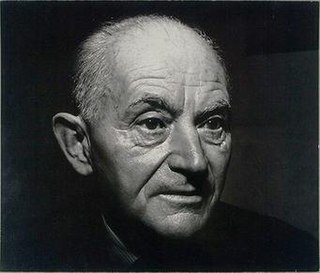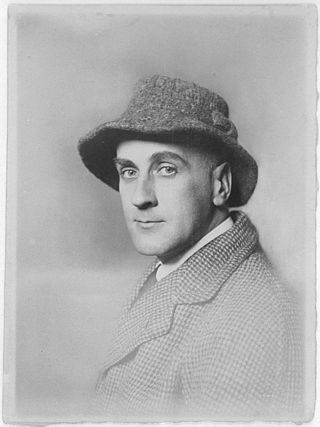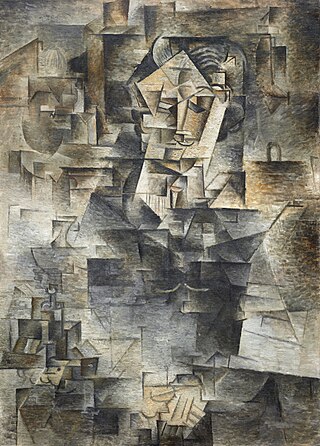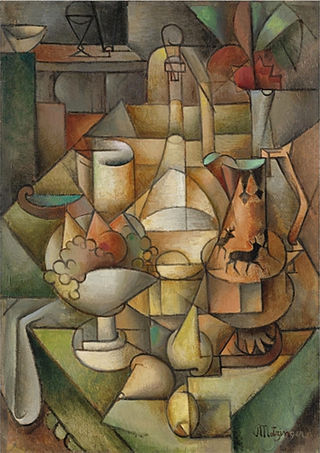
Georges Braque was a major 20th-century French painter, collagist, draughtsman, printmaker and sculptor. His most notable contributions were in his alliance with Fauvism from 1905, and the role he played in the development of Cubism. Braque's work between 1908 and 1912 is closely associated with that of his colleague Pablo Picasso. Their respective Cubist works were indistinguishable for many years, yet the quiet nature of Braque was partially eclipsed by the fame and notoriety of Picasso.

José Victoriano González-Pérez , better known as Juan Gris, was a Spanish painter born in Madrid who lived and worked in France for most of his active period. Closely connected to the innovative artistic genre Cubism, his works are among the movement's most distinctive.

Pablo Ruiz Picasso was a Spanish painter, sculptor, printmaker, ceramicist and theatre designer who spent most of his adult life in France. One of the most influential artists of the 20th century, he is known for co-founding the Cubist movement, the invention of constructed sculpture, the co-invention of collage, and for the wide variety of styles that he helped develop and explore. Among his most famous works are the proto-Cubist Les Demoiselles d'Avignon (1907) and the anti-war painting Guernica (1937), a dramatic portrayal of the bombing of Guernica by German and Italian air forces during the Spanish Civil War.

Cubism is an early-20th-century avant-garde art movement that revolutionized European painting and sculpture, and inspired related artistic movements in music, literature, and architecture. In Cubist works of art, the subjects are analysed, broken up, and reassembled in an abstract form—instead of depicting objects from a single perspective, the artist depicts the subject from multiple perspectives to represent the subject in a greater context. Cubism has been considered the most influential art movement of the 20th century. The term cubism is broadly associated with a variety of artworks produced in Paris or near Paris (Puteaux) during the 1910s and throughout the 1920s.

Daniel-Henry Kahnweiler was a German-born art collector, and one of the most notable French art dealers of the 20th century. He became prominent as an art gallery owner in Paris beginning in 1907 and was among the first champions of Pablo Picasso, Georges Braque and the Cubist movement in art.

Jean Dominique Antony Metzinger was a major 20th-century French painter, theorist, writer, critic and poet, who along with Albert Gleizes wrote the first theoretical work on Cubism. His earliest works, from 1900 to 1904, were influenced by the neo-Impressionism of Georges Seurat and Henri-Edmond Cross. Between 1904 and 1907, Metzinger worked in the Divisionist and Fauvist styles with a strong Cézannian component, leading to some of the first proto-Cubist works.

The Henie Onstad Kunstsenter is an art museum located at Høvikodden in Bærum municipality in Viken county, Norway. It is situated on a headland jutting into the Oslofjord, approximately 10 kilometres (6.2 mi) southwest of Oslo.

Albert Gleizes was a French artist, theoretician, philosopher, a self-proclaimed founder of Cubism and an influence on the School of Paris. Albert Gleizes and Jean Metzinger wrote the first major treatise on Cubism, Du "Cubisme", 1912. Gleizes was a founding member of the Section d'Or group of artists. He was also a member of Der Sturm, and his many theoretical writings were originally most appreciated in Germany, where especially at the Bauhaus his ideas were given thoughtful consideration. Gleizes spent four crucial years in New York, and played an important role in making America aware of modern art. He was a member of the Society of Independent Artists, founder of the Ernest-Renan Association, and both a founder and participant in the Abbaye de Créteil. Gleizes exhibited regularly at Léonce Rosenberg's Galerie de l’Effort Moderne in Paris; he was also a founder, organizer and director of Abstraction-Création. From the mid-1920s to the late 1930s much of his energy went into writing, e.g., La Peinture et ses lois, Vers une conscience plastique: La Forme et l’histoire and Homocentrisme.

Gino Severini was an Italian painter and a leading member of the Futurist movement. For much of his life he divided his time between Paris and Rome. He was associated with neo-classicism and the "return to order" in the decade after the First World War. During his career he worked in a variety of media, including mosaic and fresco. He showed his work at major exhibitions, including the Rome Quadrennial, and won art prizes from major institutions.

Wilhelm Uhde was a German art collector, dealer, author, and critic, an early collector of modernist painting, and a significant figure in the career of Henri Rousseau.

Water Lilies is a series of approximately 250 oil paintings by French Impressionist Claude Monet (1840–1926). The paintings depict his flower garden at his home in Giverny, and were the main focus of his artistic production during the last thirty years of his life. Many of the works were painted while Monet suffered from cataracts.

Le Bassin Aux Nymphéas is one of the series of Water Lilies paintings by French impressionist artist Claude Monet.

Portrait of Daniel-Henry Kahnweiler is an oil on canvas painting by Pablo Picasso in the Analytical Cubism style. It was completed in the autumn of 1910 and depicts the prominent art dealer Daniel-Henry Kahnweiler, who played an important role in supporting Cubism. The painting is housed in the collection of the Art Institute of Chicago.

Léonce Rosenberg was an art collector, writer, publisher, and one of the most influential French art dealers of the 20th century. His greatest impact was as a supporter and promoter of the cubists, especially during World War I and in the years immediately after.

Nature morte, or Compotier et cruche décorée de cerfs, is a Cubist painting by the French artist Jean Metzinger. It was exhibited at Exposició d'Art Cubista, Galeries Dalmau, Barcelona, 20 April – 10 May 1912. During this show—the first exhibition of Cubism in Spain—Metzinger's painting became one of the preferred targets of the press. It was exhibited again 1 – 15 April 1917 at Nya Konstgalleriet founded by the Italian Futurist Arturo Ciacelli in Stockholm. Nya Konstgalleriet was one of the three main galleries in Sweden responsible for promoting national and international modernism between 1915 and 1925. The painting would eventually be exhibited at Galerie Philippe Reichenbach, Houston, where it was acquired in 1960. In 2008 Nature morte was auctioned at Sotheby's in New York.

Les Peintres Cubistes, Méditations Esthétiques, is a book written by Guillaume Apollinaire between 1905 and 1912, published in 1913. This was the third major text on Cubism; following Du "Cubisme" by Albert Gleizes and Jean Metzinger (1912); and André Salmon, Histoire anecdotique du cubisme (1912).

Femme au miroir, Femme à sa toilette or Lady at her Dressing Table, is a painting by the French artist Jean Metzinger. This distilled synthetic form of Cubism exemplifies Metzinger's continued interest, in 1916, towards less surface activity, with a strong emphasis on larger, flatter, overlapping abstract planes. The manifest primacy of the underlying geometric configuration, rooted in the abstract, controls nearly every element of the composition. The role of color remains primordial, but is now restrained within sharp delineated boundaries in comparison with several earlier works. The work of Juan Gris from the summer of 1916 to late 1918 bears much in common with that of Metzinger's late 1915 – early 1916 paintings.

Soldier at a Game of Chess, is a painting by the French artist Jean Metzinger. While serving as a medical orderly during World War I in Sainte-Menehould, France, Metzinger bore witness to the ravages of war firsthand. Rather than depicting such horrors, Metzinger chose to represent a poilu sitting at a game of chess, smoking a cigarette. The military subject of this painting is possibly a self-portrait.

Crystal Cubism is a distilled form of Cubism consistent with a shift, between 1915 and 1916, towards a strong emphasis on flat surface activity and large overlapping geometric planes. The primacy of the underlying geometric structure, rooted in the abstract, controls practically all of the elements of the artwork.

Fruit and a Jug on a Table is a Cubist painting dated 1916 by the French artist and theorist Jean Metzinger. In 1919 the painting was exhibited in Paris at Léonce Rosenberg's, Galerie de l'Effort Moderne. The painting was reproduced in the June 1924 issue of Bulletin de l'Effort Moderne. The work is on view at Charlotte F. and Irving W. Rabb Gallery, Museum of Fine Arts, Boston.





















